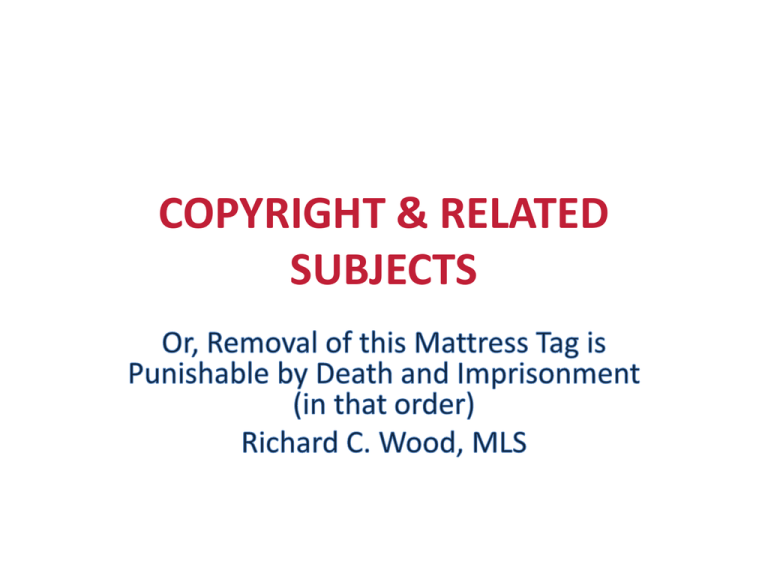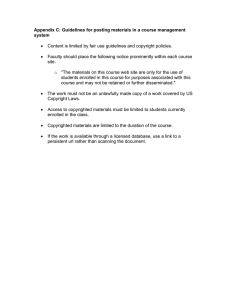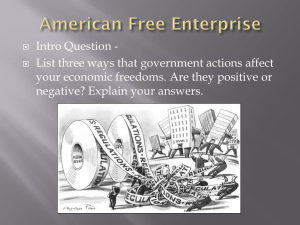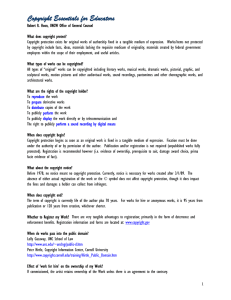COPYRIGHT & RELATED SUBJECTS
advertisement

COPYRIGHT & RELATED SUBJECTS DISCLAIMER • I’m not a copyright attorney, so sue me. • Please regard this to be information for consideration as guidelines; not tablets containing the Ten Commandments. • My objective is to make you more at ease when using copyrighted material. WHY SHOULD I CARE? • Well, for one thing, copyright compliance is the law! • For another, compliance is an individual responsibility (yours); and the institution will not usually protect nor defend your violations! • Lastly, monetary judgments are usually levied against offenders at up to $150,000 per individual incident! COPYRIGHT FUNDAMENTALS FOR FACULTY • The Constitutional Provision Respecting Copyright “The Congress shall have Power ...To promote the Progress of Science and useful Arts, by securing for limited Times to Authors and Inventors the exclusive Right to their respective Writings and Discoveries.” United States Constitution, Article I, Section 8 MORE ON THE LEGAL BASIS • The United States copyright law is contained in chapters 1 through 8 and 10 through 12 of title 17 of the United States Code. The Copyright Act of 1976, which provides the basic framework for the current copyright law, was enacted on October 19, 1976, as Pub. L. No. 94-553, 90 Stat. 2541. FROM USCFR: §102 SUBJECT MATTER OF COPYRIGHT IN GENERAL • (a) Copyright protection subsists, in accordance with this title, in original works of authorship fixed in any tangible medium of expression, now known or later developed, from which they can be perceived, reproduced, or otherwise communicated, either directly or with the aid of a machine or device. USCFR CONTINUED • Works of authorship include the following categories:(1) literary works; (2) musical works, including any accompanying words; (3) dramatic works, including any accompanying music; (4) pantomimes and choreographic works; (5) pictorial, graphic, and sculptural works; (6) motion pictures and other audiovisual works; (7) sound recordings; and (8) architectural works. MORE FROM USCFR • (b) In no case does copyright protection for an original work of authorship extend to any idea, procedure, process, system, method of operation, concept, principle, or discovery, regardless of the form in which it is described, explained, illustrated, or embodied in such work. USCFR: §105 GOVERNMENT WORKS • Copyright protection under this title is not available for any work of the United States Government, but the United States Government is not precluded from receiving and holding copyrights transferred to it by assignment, bequest, or otherwise. USCFR: §106 EXCLUSIVE RIGHTS • Subject to sections 107 through 122, the owner of copyright under this title has the exclusive rights to do and to authorize any of the following: • (1) to reproduce the copyrighted work in copies or phonorecords; • (2) to prepare derivative works based upon the copyrighted work; • (3) to distribute copies or phonorecords of the copyrighted work to the public by sale or other transfer of ownership, or by rental, lease, or lending; MORE ON CFR § 106 • (4) in the case of literary, musical, dramatic, and choreographic works, pantomimes, and motion pictures and other audiovisual works, to perform the copyrighted work publicly; • (5) in the case of literary, musical, dramatic, and choreographic works, pantomimes, and pictorial, graphic, or sculptural works, including the individual images of a motion picture or other audiovisual work, to display the copyrighted work publicly; AND MORE • and (6) in the case of sound recordings, to perform the copyrighted work publicly by means of a digital audio transmission. USCFR: LIMITATIONS ON EXCLUSIVE RIGHTS : §107 FAIR USE • Notwithstanding the provisions of sections 106 and 106A, the fair use of a copyrighted work, including such use by reproduction in copies or phonorecords or by any other means specified by that section, for purposes such as criticism, comment, news reporting, teaching (including multiple copies for classroom use), scholarship, or research, is not an infringement of copyright. FAIR USE CONTINUED • In determining whether the use made of a work in any particular case is a fair use the factors to be considered shall include— • (1) the purpose and character of the use, including whether such use is of a commercial nature or is for nonprofit educational purposes; • (2) the nature of the copyrighted work; AND MORE ON FAIR USE • (3) the amount and substantiality of the portion used in relation to the copyrighted work as a whole; and • (4) the effect of the use upon the potential market for or value of the copyrighted work. The fact that a work is unpublished shall not itself bar a finding of fair use if such finding is made upon consideration of all the above factors. TEACH ACT Technology, Education and Copyright Harmonization Act of 2002 • Essentially permits educational institutional instructors to provide students at distance the same access to copyrighted handouts that traditional on-campus/in class students enjoy. • Institution must have copyright policy. • Institution must be non-profit and accredited. • Materials must be provided by the institution which accurately describe, and promote compliance with, the laws of the United States relating to copyright. TEACH ACT CONTINUED • Institution must publish statements to students that state that materials used in connection with the course may be subject to copyright protection. • Materials transmitted must be solely for students officially enrolled in the course for which the transmission is made. CONTU/CONFU WHAT ARE THEY? • CONTU: Commission on New Technology Uses of Copyrighted Works (1978). • CONTU and its Guidelines are generally aimed at library copying and computer usage. Agreement between publishing industry copyright owners and the library community was reached and articulated in the Guidelines. MORE ON CONTU Essentially libraries were permitted to make five copies from a single journal title or a chapter of a book title without seeking permission. Items copied were drawn from the most recent five years of a journal’s run or a book’s publication. Items older than five years were not addressed, but are generally con-strued to lie outside of consideration. After the limit of five is reached, permissions have to be obtained from copyright holder. CONFU • CONFU: Conference on Fair Use (1997). • Convened to attempt to define Fair Use. • No agreements were reached between end users and copyright holders (almost 100 organizations on both sides of the issue of fair use). • Meeting was largely a failure. SO, CAN I USE FAIR USE FOR DISTANCE EDUCATION CLASSES? • Absolutely, but exercise reasonable care. • Journal articles: One per issue. If over five from a single title in the last five years, seek permissions. • Book chapters: one per title. If more, seek permissions. COPYRIGHT STATEMENT • Anything mounted for use must have copyright statement: “Material displayed herein may be copyrighted material. The copyright law of the U.S. (Title 17, United States Code) governs the making of photocopies or the other reproductions of a copyrighted material.” • This is also a good statement to use on the course page. FAIR USE CONTINUED • Course pages must be protected by ID and password. • Copyrighted content must be removed at end of course and not renewed on consecutive terms. PUBLIC DOMAIN: BEYOND FAIR USE • Public domain material lies outside of Fair Use and may be freely used. • If material is in the public domain, it can be used without regard to copyright limitations. • But how do I determine if something is in public domain? LOLLY GASAWAY WHEN U.S. WORKS PASS INTO THE PUBLIC DOMAIN By Lolly Gasaway, University of North Carolina • Definition: A public domain work is a creative work that is not protected by copyright and which may be freely used by everyone. GASAWAY CONTINUED The reasons that the work is not protected include: (1) the term of copyright for the work has expired; (2) the author failed to satisfy statutory formalities to perfect the copyright or (3) the work is a work of the U.S. Government. GASAWAY CHART http://www.unc.edu/~unclng/public-d.htm • Date of Work: Created 1/1/78 or after. Protected from: When work is fixed in tangible medium of expression. Term: Life +70 years,1 (or if work of corporate authorship, the shorter of 95 years from publication, or 120 years from creation.2 CHART CONTINUED • Date of Work: Published before 1923. Protected from: In public domain. Term: None. CHART CONTINUED • Date of Work: Published 1923-63. Protected from: When published with notice.3 Term: 28 years + could be renewed for 47 years, now extended by 20 years for a total renewal of 67 years. If not so renewed, now in public domain. CHART CONTINUED • Date of Work: Published 1964-77 Protected from: When published with notice. Term: 28 years for first term; now automatic extension of 67 years for second term. CHART CONTINUED • Date of Work: Created before 1-1-78 but not published. Protected from: 1-1-78, the effective date of the 1976 Act which eliminated common law copyright. Term: Life + 70 years or 12-31-2002, whichever is greater. CHART CONTINUED • Date of Work: Created before 1-1-78 but published between then and 12-31-2002. Protected from: 1-1-78, the effective date of the 1976 Act which eliminated common law copyright. Term: Life + 70 years or 12-31-2047 whichever is greater. GASAWAY FOOTNOTES • 1. Term of joint works is measured by life of the longest-lived author. 2. Works for hire, anonymous and pseudonymous works also have this term. 17 U.S.C. § 302(c). 3. Under the 1909 Act, works published without notice went into the public domain upon publication. GASAWAY FOOTNOTES CONTINUED Works published without notice between 1-178 and 3-1-89, effective date of the Berne Convention Implementation Act, retained copyright only if efforts to correct the accidental omission of notice was made within five years, such as by placing notice on unsold copies. 17 U.S.C. § 405. (Notes courtesy of Professor Tom Field, Franklin Pierce Law Center and Lolly Gasaway) PERMISSIONS???? • If you have determined that you need to use an item that will not be permitted for use under the Fair Use Doctrine, you must seek permission for such usage. • HSC OP 57.02 Attachment A has a sample permissions letter that you may use. • HSC OP 57.02 lists the agencies and addresses to contact for such permissions. PERMISSIONS CONTINUED • When seeking permissions remember that it is best to plan ahead, as it may take some time to gain permissions. • Some permissions are given for free, while others may carry significant costs per item. See next screen to see significant cost example. PERMISSI0NS EXAMPLE • As an example, to seek permissions from CCC for a 25-page article from a 2010 issue of Acta Ophthalmologica Scandinavica for use by 50 distance students in a course management system, the charge would be $253.50 for the semester. • Ready to consider using Fair Use again? RECAP:GUIDELINES FOR DISTANCE EDUCATION USAGE • Limit of 5 journal articles per title (5 from the last 5 years). • Sparing use of images and/or book chapters. • Limit to only students enrolled in class (password and user ID protect). • Take offline at completion of course. Do not use consecutively. • Where possible give bibliographic citation instead of full text. GUIDELINES CONTINUED • If you must exceed limits, obtain permissions. • Always include copyright statement on copies used: “Material displayed herein may be copyrighted material. The copyright law of the U.S. (Title 17, United States Code) governs the making of photocopies or the other reproductions of a copyrighted material. (continued) GUIDELINES CONTINUED • Under certain conditions specified in the law, it is legally possible to furnish a photocopy or other reproductions. One of the specified conditions is that the photocopy or reproduction is not to be "used for any purpose other than private study, scholarship, or research." If a user makes a request for, or later uses, a photocopy or reproduction for the purposes in excess of ‘fair use’ that user may be liable for copyright infringement.” MY PERSONAL COPYRIGHT ANGELS • Georgia Harper, University of Texas: creator of A Crash Course in Copyright, http://copyright.lib.utexas.edu/ I highly recommend her crash course for a full understanding of all aspects of copyright. ANGELS CONTINUED • Lolly Gasaway, University of North Carolina, http://www.unc.edu/~unclng/index.htm Her courses on copyright law are systematic and thoroughly comprehensive in nature. Her course on copyright for librarians is a classic: highly recommended. CLOSER TO HOME • Please remember to read the TTUHSC OP entitled Guidelines for the Educational Use of Copyrighted Works, HSC OP 57.02, and its accompanying Attachment A (Sample Letter for Permissions). http://www.ttuhsc.edu/hsc/op/op57/op5702. pdf This OP is intended to provide you with overall guidelines for copyright compliance. CLOSING • Please remember to consult with the Office of General Counsel/TTUHSC Affairs should you have any questions concerning copyright law. (806) 743-2986 Fax# (806) 743-1857 • Thank you for your courteous attention. Reviewed February 2014




